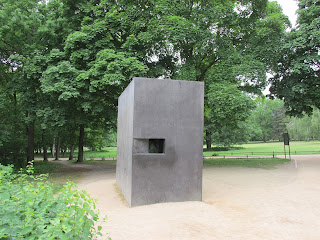Ignore the bust - and admire the beauty of the gold leaf decorations of the niche. I never tire of going to the Alte Nationalgalerie on Museuminsel in Berlin. It is a stunning building that was decimated in the second world war, but has been lovingly restored. One room has been kept so that we can know the state from which it has been brought.
All else has been restored in a convincing and attractive manner. I especially love the doorways on the main floor, and the dome on the third floor. The doorways "pull" you through the galleries, and the dome is a restful place that introduces you to the heart of the collection.
So the question that seems to naturally follow here is why do I keep coming back here. What, other than the building itself, is the nature of the attraction. Sometime in the 1970s, I read a book called Dreamers of Decadence by Philippe Julian, and Robert Baldick. In it I met Odilon Redon, Edvard Munch, Gustav Moreau (whose atelier in Paris I visited once), and Jan Toorop among others. There was one artist in that discussion on Symbolist painters that I immediately took to, and that is Arnold Böcklin. There are several paintings by him here, some portraits, and landscapes, but above all his symbolist paintings. I am especially taken by the painting, "The Island of the Dead."
So I had to ask myself the question, "What is it about these romantic painters, with their slightly bitter edge, that is so attractive to me?" Today, as I thought about that, I think I realized something and that is that these painters still were cognizant and conversant with the myth (whether Christian, classical, or tribal). It is an orientation that we seem to have lost in our time. As an illustration, here is Franz Stuck's painting "Die Sünde" (Sin), which was painted in his lovely studio at Villa Stuck in München.
Here the "evil" woman (taking the myth seriously) looks at us from the canvas, with the serpent peering at us as well over her shoulder. I don't like what the canvas says about women, but I do like all the cultural references that are there to be thought about and brought to mind. There is a challenge here to think about sin as a cultural force and as a religious concept, and its attachments in the culture at large.
There is an early Max Beckmann, in which you can see how his modernist definitions of space and human form was beginning to develop. Although not a symbolist, he certainly understood myth and classical tales in his later works.
Then there is a haunting portrait of Hegel by Jakob Schlesinger, in which the philosopher stares out at us, but beyond us - deep in thought.
Finally, I couldn't help but photograph this wonderful painting by Anton Feuerbach, a painter steeped in classicism, but reaching for the modern. Finally, there is something here that explores deeply what it means to be a human being, at all points of the culture.
And, perhaps, divine as well.




























































